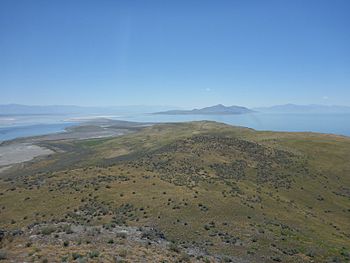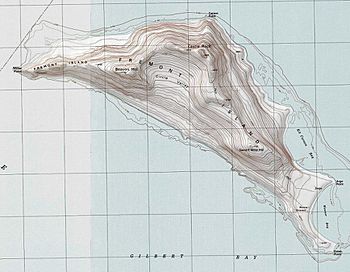Fremont Island facts for kids

View from Castle Rock, looking south toward Antelope Island, August 2014
|
|

Fremont Island map
|
|
| Etymology | John C. Frémont |
|---|---|
| Geography | |
| Location | Great Salt Lake |
| Coordinates | 41°09′56″N 112°20′23″W / 41.16556°N 112.33972°W |
| Area | 11.91 km2 (4.60 sq mi) |
| Length | 8.57 km (5.325 mi) |
| Width | 2.76 km (1.715 mi) |
| Administration | |
| State | Utah |
| County | Weber |
Fremont Island is a large island in the Great Salt Lake in northern Utah, United States. It covers about 11.91 square kilometres (2,943 acres). It is the third largest island in the lake, after Stansbury Island and Antelope Island.
This island has had many names over time. Some of these names include Castle Island, Coffin Island, Disappointment Island, and Miller Island.
Contents
Exploring Fremont Island's Past
Fremont Island is named after a famous military leader and explorer, John C. Frémont.
Early Explorers and Naming the Island
In April 1848, pioneers from the Salt Lake Valley explored the area by boat. They called it "Castle Island" because a part of the island looked like a throne.
The name Fremont Island was first used in 1850. This was when Captain Howard Stansbury surveyed, or mapped, the Great Salt Lake. This name eventually became the official one.
In 1859, two men from Farmington put 153 sheep on the island. They even called it "Miller's Island" after one of them, Dan Miller.
The Story of Jean Baptiste
In 1862, a man named Jean Baptiste was sent to live on the island by Brigham Young. Baptiste had been arrested for stealing from many graves.
After about three weeks, Baptiste managed to escape from the island. Cattle herders later found signs that he might have tried to build a raft to get away. No one ever knew what happened to him after his escape attempt.
Mining and Family Life on the Island
In the early 1870s, people tried to mine for valuable metals on Fremont Island. However, not many mining claims were made.
In 1886, a judge named Uriah J. Wenner moved his family to the island. He had a lung illness called tuberculosis and hoped the remote island would help him.
The Wenner family lived there until Uriah died in 1891. He was buried on the island. His wife, Kate, later left the island. When she passed away in 1942, her ashes were placed next to Uriah's grave on the island.
Recent Changes and Preservation Efforts
In 2003, a company leased the island. They brought in non-native animals for special hunting trips.
In 2013, a wild pig was seen near the Antelope Island causeway. This led state officials to investigate and find other illegal animals. The state and the owners worked together to remove these animals, often using planes, to stop them from spreading to the mainland.
In 2018, a group of investors, including David Sparks, bought Fremont Island. Conservation groups worried about what might happen to the island. They hoped the State of Utah would buy the land to protect it.
In December 2020, The Nature Conservancy bought the island to stop it from being developed for businesses. They then donated it to the State of Utah. Now, the state owns and manages the island for public use and recreation. The Nature Conservancy also has an agreement to make sure the island stays protected.
How to Visit Fremont Island
Fremont Island is owned by the State of Utah. It became state property on December 5, 2020.
Getting to the Island
You can reach the island when the Great Salt Lake's water level is low. At these times, a sand bar becomes visible. This sand bar starts about 1 mile east of the Antelope Island Marina. You can get to this starting point from the Antelope Island causeway.
If you want to go by boat, it's best to use a flat-bottomed boat. The water near the island is very shallow. Walking or biking to the island can be muddy. It's often easier to visit when water levels are low or during winter when the mud is frozen.
Plant Life on Fremont Island
Fremont Island is home to certain types of plants. There is also old information that shows some plants that used to grow there are no longer present.
For example, explorers in the mid-1800s wrote about many "onions" on the island. They identified these as Calochortus luteus. However, this name was later used for different plant species. While it's unlikely the specific C. luteus from California grew there, it seems clear that some type of Calochortus flower that was once on Fremont Island is now gone.
See also
 In Spanish: Isla Fremont para niños
In Spanish: Isla Fremont para niños

